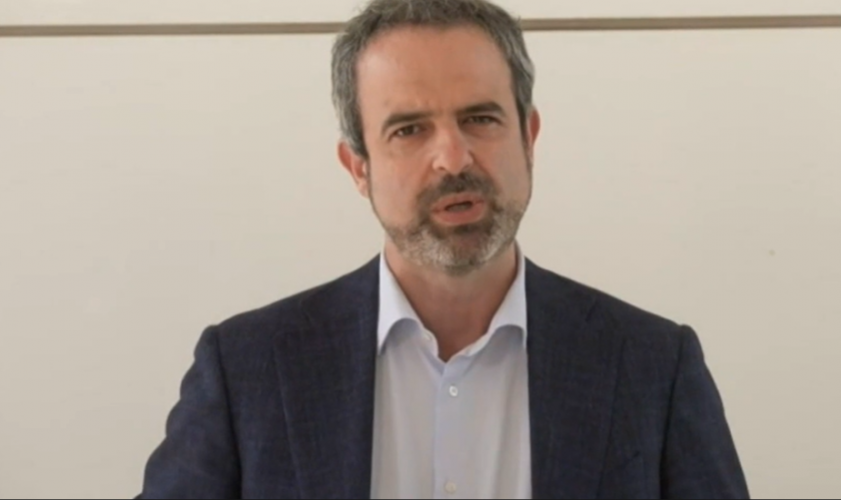Dr Omar Khorshid on hospitals and opening up, vaccinating children under 12, the over 60s and mandatory vaccination for healthcare workers
Transcript: Dr Omar Khorshid spoke to media at a doorstop interview on Thursday 2 September, 2021

DR OMAR KHORSHID: The AMA is today calling on National Cabinet to look at the capacity of our hospital system, not just ICU beds, but our whole hospital system, to make sure that once we open up, we don’t see a disastrous reduction in the care available to Australians who are sick simply as a result of increase in the risk of COVID in the community from opening up. And of the hospitals having to pivot towards treating COVID without treating all those other conditions that people currently present with.
The reality in public hospitals in Australia right now is that they are full, they are always full, and there are ambulances parked outside, too many of them as we speak, simply because the hospitals don't have the capacity to look after the healthcare needs of Australians. That's before COVID. And we know that as soon as COVID comes into the community, hospitals will have to stop doing elective surgery. They will have to turn their ICUs into COVID ICUs. And that means people not being able to access lifesaving cancer surgery, lifesaving heart surgery, because the ICUs will have very sick COVID patients to look after, patients who stay in the ICUs for weeks and weeks.
Now, we are not worried that our system will fail to look after COVID patients. We think the planning has been done, but we are worried about Australians who get heart attacks, who need surgery, who have a sore hip, who are going to miss out on care if we don't get the planning right. Our hospitals are starting from a position of being completely overloaded, and adding more to that load is only going to make things worse. So we're asking National Cabinet to take that into account with their planning. Is it right to open up at 70 or 80 percent if the hospitals are going to predictably fail within weeks? Which will, of course, send us straight back into lockdowns, which would be extremely disappointing for all Australians or is there a better way to plan to use our system, to make sure that the resources that we do have, limited as they are, can be best pointed towards the most efficient care possible?
Now, we're asking for planning not just around ICU beds, but around all the processes, the staffing, how we deal with COVID in hospitals, how we run our primary healthcare sector, so that we've got the best chance that when Australia does open up to the rest of the world, when we do open up our interstate borders, that we have a healthcare system available to everybody who needs it. It’s a pretty simple ask, but it's a complex task. And we believe that we must use the available weeks and months that we have, to get that planning done so that the healthcare system doesn't become the handbrake on Australia's economy and our ability to open up.
QUESTION: How can those issues, the strain on the hospital system, be fixed in a matter of weeks?
OMAR KHORSHID: So we can't fix the capacity of the hospital system in a matter of weeks, but what we can do is recognise how limited it is and make sure that the plans take that into account. In the longer term, though, the AMA is also asking all our governments, our Federal Government and our state governments, to make the necessary investments in hospital capacity, because the projections are very clear: we have more Australians with more complex health needs, and that's only going to get worse post-COVID. We must plan for the future, and that means investing in the long term needs of our community, not just a Band-Aid to keep the public hospitals working during COVID.
QUESTION: We're already hearing that new ethical guidelines are being distributed at Sydney hospitals for doctors potentially having to decide which patients to prioritise for ventilation, which patients can survive. Also, emergency departments are closing to non-COVID patients. I mean, has that ship sailed in Sydney?
OMAR KHORSHID: Sydney is an example of what is inevitable in every state and territory when COVID starts. The care for everybody with anything other than COVID will be less available. EDs may have to close and ICUs may have to make difficult decisions about who to treat and who not to treat. However, doctors are used to that. We are used to making tough decisions, and we are used to not wasting valuable healthcare resources on people who aren't going to benefit from it. Australians can be comfortable that if they get COVID, they will be looked after. What the AMA is not comfortable about is our ability to keep our system running, to look after people with appendicitis, with a heart attack, or who need elective surgery as we face endemic COVID. Because once COVID’s here, it's not going away. It will continue to stress our public hospitals for the foreseeable future. And it's critical that the longer-term investments are made now, but even more critical that the short-term plans are put into place to make the best of the system that we do have.
QUESTION: Do you think that's the real reason the states like Western Australia and Queensland are now balking at opening at 80 per cent, because they realise they can't cope?
OMAR KHORSHID: I think it's fair to say that in a state like Western Australia, where there were 6,000 hours of ambulance ramping last month, there is no chance their public health system could cope with any additional demand from COVID without severely curtailing other care. That's already happening today in Western Australia. And it's one reason why opening up at 80 per cent may not be possible for Western Australia. We'd like modelling to be done to look at the reality of our public hospital system, what it can cope with, and do we need to go higher than 80 per cent just in order to protect the hospital system? And I think we need to be realistic here. When we do open up, we're not talking about Freedom Day. We're talking about potentially reducing the borders between states, potentially reducing the borders to other countries. But we will continue to need to manage COVID by using public health measures. That means social distancing restrictions. And if we don't get this right, it will mean ongoing lockdowns even once we are fully vaccinated, because we've seen in other countries, hospital systems only have a certain capacity. And once they're exceeded, if you get COVID, you could easily die. And that could have been prevented if the planning had been done better.
QUESTION: In asking National Cabinet to consider whether it is still possible to reopen at 70 or 80 per cent, do you believe that it is still wise to reopen, according to the national plan’s current schedule?
OMAR KHORSHID: The AMA is keen for all our governments to be honest with the people of Australia and for a conversation to occur in a more constructive way than what we're seeing at the moment between now premiers and our Federal Government. The reality is this is complex. It is uncharted territory. And the circumstances are likely to change before we get to the end of the year. But we all want the same thing. We all want Australians to be safe. But we also have to recognise, COVID is coming to every single state and territory. There is no COVID-free future for any of us. And we have to make that transition at some point. So the question is, when is it safe? And on the Doherty modelling, it looks like it's reasonably safe, if everything else works, at 80 per cent. But that modelling also says that we will need ongoing restrictions. We will need to potentially go to lockdowns from time to time. And what we're saying is, that those lockdowns are actually going to be entirely predictable if the health care system isn't ready, and if we open up too early. So we've got those two things to do. One is look at when we should open up, in terms of the vaccination rate. And the other is to do everything possible to make sure our system is ready to deal with that demand. And that means using the resources that we have. It means using our general practitioners and primary health care networks to actually look after people with COVID, rather than them coming to hospital, in conjunction with hospitals to make sure that the sick people are where they need to be. And it means potentially doing things like splitting up COVID care from non-COVID care. So we keep some hospitals available to do those critical procedures and elective surgeries that Australians need but won't be able to access if the public hospital system is in crisis.
QUESTION: Dr Khorshid, how concerned are you specifically about the level of hospitalisations in New South Wales at the moment?
OMAR KHORSHID: The situation in New South Wales is very troubling in certain areas. We've seen the pressure on the western Sydney hospitals resulting in them having to stop taking new admissions and to pivot pretty much largely to COVID care. Now, that's not the case around all of Sydney. It's a big city and there are much lower levels of cases in the eastern suburbs, for instance. But we've got no elective surgery going on. We've got a private sector that has been told to stop operating as well. And hospitals are actually sitting idle. So there's an awful lot of people in New South Wales not getting the health care that they need because we're dealing with this COVID crisis. Now, once we open up, the numbers are not going to be 1000 a day or 1300 a day. They're going to be in the tens of thousands a day. And that will cause a predictable increase in demand on hospitals. And we must take this opportunity to plan for that.
QUESTION: Given the need to transition you've referred to, is the Queensland Premier's estimate of 2000 deaths a day and concern about COVID ripping through unvaccinated children inflammatory?
OMAR KHORSHID: I think the current tone of conversation between our national leadership is disappointing. It is alarmist. And it's not helping us plan for the future. The reality is that no one running a health system or a government is going to allow thousands of people to die every day in Australia. They will actually bring in the lockdowns. They'll bring back the restrictions if they need to, to protect lives. But we also need to recognise the cost of that on the freedoms of every Australian. The lack of health care that's possible during lockdowns and of course, the economic impact on everybody. We can avoid that situation if we get the planning right. And opening up too early is just going to be a recipe for having to close down again very quickly, which I think would be a terrible outcome for all Australians.
QUESTION: Given a vaccine for under-12s is likely still a long way away, what is the risk for children? And are borders the only way to protect them, or given lower acuity of illness, are we able to live with COVID with children under-12 unvaccinated?
OMAR KHORSHID: Around the world, countries are living with COVID, with largely vaccinated adult populations and children who unfortunately have not yet had access to vaccines. We're seeing a lot of children getting infected, but not a lot of children needing hospitalisation or getting very sick. That is the reality. Children are much less susceptible to COVID than adults, and in particular than vulnerable adults. But should we protect children? Absolutely we must. So if we have a vaccine, by the time we're thinking about opening up, we should obviously give it to our children. And that may delay our opening up, because why would you expose children if you don't need to, to a potentially very serious illness? But if we don't have a vaccine, there are other ways to protect children. For instance, having every adult vaccinated will protect children. Looking at the ventilation in classrooms, looking at the social distancing that’s necessary in schools, looking at hybrid learning environments, are other ways that we can continue to protect children whilst we wait for a vaccine, if there isn't one available when Australia has to open up. These are all questions for the future. And I think it's really not helpful to lock anyone into fixed dates, fixed numbers, because at the end of the day, I think our leaders need to do the right thing by the public when each decision needs to be made on the circumstances as they arise at the time.
QUESTION: So you don’t think unvaccinated children is reason enough to maintain interstate borders after 80 per cent adult double vaccination?
OMAR KHORSHID: Each premier will make their own decisions, but I would counsel each of those premiers to look at the big picture impact of all of their decisions. To look at the impact on families, remembering that children are susceptible to poor outcomes by being locked out of school, that they're susceptible to poor outcomes by being kept in an unsafe home environment. School is a great place for children. And if we can open up our societies in a safe way that protects children, that's the best thing to do. Children are also affected by closed borders, and we need to be mindful of that and find that balance, as I think we've had to do throughout the pandemic. And that is going to be the ongoing reality. We're not going to have Freedom Day and everything's back to normal. We're going to have to keep managing COVID, even in a vaccinated population. And I think we need to prepare ourselves for that reality.
QUESTION: So should children, then be included in the vaccination threshold before a decision on opening state borders?
OMAR KHORSHID: The decision on whether children should be included, is actually going to be dependent on whether vaccines are available. And the reality is, right now, there is not a licenced vaccine available for children under the age of 12 in Australia or, in fact, anywhere in the Western world. So we just need to deal with the realities. It may be possible to open Australia up and still protect our children. That will depend on how successful we are at vaccinating our adult population and how well we control the virus. Maybe we open up a little, but we keep social distancing restrictions in place in order to protect children. There's a lot of potential ways forward. The best would be is if we have a safe and effective vaccine for the under twelve's that's able to be distributed either through a school mechanism or even during the school holidays. That'd be great. But we just don't know at this stage if that's going to be possible.
QUESTION: We’re still seeing a lot of health care workers across the system refusing vaccinations. To what extent should it be mandatory for health care workers, especially given that some businesses, some companies, are making it mandatory for their employees?
OMAR KHORSHID: The AMA has called for all health care workers to be vaccinated and for that to be mandatory, not just frontline health care workers, but everybody who works in health care settings, everyone who works in a hospital, everyone who works in a GP practise, a pharmacy or in an ambulance retrieval service, that is to protect the workers themselves. Providing a safe workplace is an obligation for all employers. And employers are in a difficult situation right now, giving conflicting advice from their lawyers about what they're allowed to do and what they aren't allowed to do. So what employers need, particularly those employers in a health care setting, is public health orders from our state governments that say vaccinations will be mandatory in the health sector on date X. And obviously, we must provide access to vaccines for all health care workers first before you mandate it. But once there is a target there, I am confident that the vast majority of health care workers and all other workers in those settings will go and get themselves vaccinated because it's the right thing to do and they want to keep their jobs.
QUESTION: The WA Government is announcing today mandatory vaccination for health workers beginning with ICU and critical care staff, how much of a danger is there that whatever small proportion it is that still don't want the vaccine will leave frontline EDs and ICUs even more shorthanded than they already are?
OMAR KHORSHID: So there's a difference between people who haven't been vaccinated yet and refusing vaccines. And I'm confident that most health care workers, faced with a very clear message from their employers and from the government that they must get vaccinated, will go and do the right thing. It's the right thing by their patients and that's ultimately what their work entails day in and day out. If there are a small number of health care workers who are implacably opposed to vaccines, then I think there isn't a place for them in our health care workforce, in a COVID environment, that is the reality of providing a safe workplace, of looking after vulnerable patients. And it's not fair to a patient that is sick in hospital that they be exposed potentially to COVID because a staff member has refused to do the right thing.
QUESTION: Given the aged care cohort is still lagging ahead of its 17 September deadline that you’re confident the health workforce will front up and get the jab?
OMAR KHORSHID: Health workers have already fronted up to get the jab. I know in the medical profession there's an extremely high rate of vaccination because doctors are fully aware of the benefits of vaccination. And they watch with horror the realities of COVID around the world. Nurses again have a very high level of vaccination, but perhaps not quite as high. And then it probably drops away as we get further away from the patient into our clerical and other staff in hospitals. But one of the things that's been easy for health care workers is they've had access, there've been clinics in hospitals that can go down and get a vaccine. It's been much harder for health care workers in the community, and it's certainly been harder again for aged care workers. So we do need to supply access to vaccines. It's easy. And look at things like leave for those who may experience some short-term side effects. Those measures have been put in place in aged care, and they're appropriate too in health care settings for those small numbers of people who haven't yet been vaccinated.
QUESTION: Given they have been prioritised from the beginning, is there a level of absurdity for the number of health care workers that still haven't actually gone out and got vaccinated?
OMAR KHORSHID: People have a lot of different reasons for not being vaccinated, ranging from just haven't gotten around to it, inconvenience, to access, to some level of hesitancy. And then, of course, there's a small number of Australians who are opposed to the concept of vaccination or who are very worried about the safety of COVID vaccines. The message, though, has been very clear right from the start. These vaccines are incredibly safe. They've saved millions of lives around the world already, and they are saving lives in Sydney and Melbourne right now. It is the best thing that you can do for your health to go and get vaccinated. And every health care worker must take that step in the near future for us to be able to open up into an environment where there is COVID everywhere in our community, that people can still access safe health care.
QUESTION: There's all this talk about the national plan and us all moving forward together. Do you concede that potentially we will get to the stage where Australia will have different states doing different things? Opening, possibly some not opening. Do you concede that that might be the way to go for those states that are quite hesitant to open up?
OMAR KHORSHID: At the moment, it's hard to see a future where Australia opens up all in one go with all the states and territories doing the same thing at the same time, partly because they're starting from very different positions. The decision on when and how to open up in New South Wales is very different to the decision in Western Australia, a different level of risk, a different level of harm associated with not opening up. So I do expect the states will do their own thing, but hopefully we can regain that national solidarity that we've had at times during this COVID crisis and allow our country to function again as a country. But I do understand each premier wants to do the right thing. Each government has its own set of responsibilities. And at the end of the day, the health of the communities is a direct responsibility of each state and territory government.
QUESTION: The prime minister's sending a letter to all 60 to 69 year olds, urging them to get AstraZeneca if they haven't already. It's still the recommended vaccine of that age cohort. Should they have the choice of Pfizer? Do you support the encouragement that they get AZ? And what would you say to those in their 60s who say they're waiting for Moderna?
OMAR KHORSHID: The simple message for everyone over 60 is just to go and get vaccinated. It's been the message right from the start, and it remains just as true today as it was several months ago. The AZ vaccine is extremely safe. It is extremely effective, and it may end up being the better of the two vaccines in terms of protecting you from COVID in the long term. This idea that Pfizer is somehow better is a fiction and it always has been. And in fact, we're already starting to wonder about whether Pfizer immunity is starting to wear off earlier than AZ immunity. So over 60s should get AZ immediately. There is AZ available in large numbers right across the country, and it is the best way to protect your health. For those who are waiting for Moderna, you're going to be waiting a fairly long time. The government have said you will eventually have access to one of the mRNA vaccines. But the Pfizer and Moderna vaccines are exactly the same. They're being made available to the same groups at the same time. And the announcements as to when you may have access to an mRNA vaccine have not yet come from government. And we've got no advice yet as to when that might be.
QUESTION: Is that as true for in WA, as Sydney, I mean, obviously COVID free in WA at the moment, that is why a lot of 60s, I think, are thinking they've got time to wait and delay getting AstraZeneca.
OMAR KHORSHID: It's only a matter of time before COVID gets into WA. And this idea that WA can remain COVID free in the long term is a fiction. It will only take one truck driver, one ship coming into Fremantle port, one breach of protocols in a hospital for the virus to escape. And as we've seen in- now in New South Wales, in Victoria, and in Auckland, the Delta strain is very difficult to contain. And even with a strict and rapid lockdown, you may not win that fight. And we could be facing a significant Delta outbreak here in Perth tomorrow. So the only way to protect yourself is to get vaccinated. And the AMA's advice to all Australians is do not wait. Go and get yourself vaccinated. We do need to prioritise the Pfizer vaccine for those younger groups. And in fact, the modelling now tells us that by prioritising younger Australians, we're actually going to help control the virus better at this point now that we've got a fair proportion of our older Australians vaccinated. So what is being done by government is right. And my advice to all Australians is follow the government's advice and go and get any vaccine that's available to you today.
QUESTION: So those states that are holding out for COVID zero like WA, is that a delusion?
OMAR KHORSHID: The idea of COVID zero in the long term is a delusion. It is not going to happen anywhere in the world. And we cannot remain isolated forever. We may have the luxury of being able to choose when WA opens and when we let COVID into our state. But we may not. We've already seen a number of outbreaks with different strains that we've been able to get on top of. But Delta is different, and we have to expect a Delta outbreak is possible from any time from today in Western Australia. And we need to be planning for that.
QUESTION: But is COVID zero a necessary policy when your vaccination rates around 30 per cent and you’re cancelling elective surgery?
OMAR KHORSHID: Yes. So protecting Western Australians from COVID right now is the right policy decision. And the AMA is certainly not suggesting that the borders be opened internationally or to any high-risk state in Australia. The reality is we have the lowest vaccination rates in the country. But part of that perhaps is because Western Australians feel safe. And we've seen the vaccination rates in New South Wales and Victoria jump up significantly as soon as people have seen that COVID is a real and present danger to their own safety. Now, the message for everybody is COVID is a real and present danger to your safety everywhere in Australia right now, including in Western Australia. And it's critical that we vaccinate our entire community as fast as we can.
QUESTION: By contrast, New South Wales is 70 per cent one dose today and unlimited exercise now for the residents in the hotspots. Is that easing of restrictions at just 70 per cent one dose appropriate?
OMAR KHORSHID: The mixed messages, that easing of restrictions set out do worry us. Now, whether each individual measure is going to have an impact is very hard to know. But the idea that you are starting to relax restrictions at a time when your hospital system is in crisis and you have record numbers of people both dying of COVID and in hospital with COVID, it is troubling. And any further relaxation of restrictions over the next few weeks does risk those hospitals getting further overrun and more people in New South Wales getting sick with COVID. But of course, the people that get sick are going to be those that have not been vaccinated. So that simple message remains, if you want to avoid COVID in New South Wales, if you want to avoid ending up in hospital and potentially on a ventilator in ICU, go get a vaccine.



